Assessment of Lentic-Lotic Basin Biodiversity Improvement through a Cyclic Platform Process of Management
22.05.2012
-
SUBMITTED ORGANISATION :
-
International Lake Environment Committee Foundation (ILEC)
-
DATE OF SUBMISSION :
-
22/05/2012
-
REGION :
-
Global
-
SUMMARY :
-
In spite of their global significance, many lakes and other inland waters around the world are in a critical condition and will be most severely affected by the global warming and various human interventions because of their lentic (static) nature as water systems. In coping with such situations, the International Lake Environment Committee Foundation (ILEC: c.f. Attachment 1) has developed a methodological framework called ILBM (Integrated Lake Basin Management) and the ILBM Platform Process. This paper focuses mainly on two subject areas; one being the presentation of the methodological framework itself, and another being five ILBM case studies from various parts of the world on biodiversity conservation and enhancement. All of the case study topics pertain to the challenges faced by the typical lentic-lotic (e.g., lake-river, pond-stream, wetland-feeder river) systems in developing countries faced with a rapid decline in ecosystem integrity, particularly with regard to biodiversity. Lastly, the paper analyzes the scope of application of ILBM Platform Process, the knowledgebase cum knowledge mining system called LAKES (Learning Acceleration and Knowledge Enhancement System) and the networking of the biodiversity case study projects within the lentic-lotic environments. The proposed methodology may have a wide application possibility to the lateral analysis as well as to the governance improvement process of other biodiversity cases than those related to ILBM.
-
KEYWORD :
-
Integrated Lake Basin Management (ILBM), biodiversity-based platform process, knowledgebase and knowledge mining
I. Introduction
The riparian and watershed basins of lentic-lotic (e.g., lake-river, pond-stream, wetland-feeder river) systems are among the most bio-diverse ecosystems on the globe, and they have been facing serious threats of degradation. The lack of methodological framework for application to practical management is one of the major reasons why such degradation threats have been ubiquitously persisting across the globe. To address this challenge, ILEC has been promoting the concept of ILBM over the past decade or so. With the growing body of knowledge in the application of ILBM concept, ILEC is now configuring a methodological framework called the ILBM Platform Process. The framework aims to serve as a guide in attaining a suitable level of resource sustainability through gradual, continuous and holistic improvement of basin governance as necessary. With the associated knowledgebase system, LAKES, the ILBM Platform Process has so far proven to play an instrumental role in the pursuit of sustainability in lake basin management including those pertaining specifically to the lake-basin biodiversity issues. The proposed approach, i.e., the combined use of the ILBM Platform Process and the LAKES knowledgebase system would be applicable to thematic cases beyond lake basin management, such as river basin and forest resource management. Further, the cyclic nature of the Platform Process and the knowledgebase development focused on key issue domains of governance (as related to institutions, policies, participation, technology, information and finance) has good potential to serve well in dealing with such broad-scoped subjects as biodiversity enhancement.
II. Integrated Lake Basin Management (ILBM)
Integrated Lake Basin Management (ILBM) is a conceptual framework designed for assisting managers and stakeholders in achieving sustainable management of lakes and their basins, with its six fundamental pillars for governance improvement as shown in Table 1. The primary characteristic of ILBM is that it is not a prescriptive planning procedure. Rather, it is a compilation of lessons learned from the global experiences of lake basin management in the past, synthesized to address complex planning issues with a basin governance framework that reflects the unique features of lentic waters such as lakes and reservoirs (i.e., long retention time, complex response dynamics, and integrating the surrounding environment and human activities).
For a successful lake basin management, it is essential to fill the gaps between what has already been done, and what remains to be achieved in its application process with long-term and strong political commitment. Continuous efforts will be necessary to further expand and refine the concept of ILBM for a better future of lakes and other water bodies that are now under serious threat of degradation, particularly caused from human activities and climate change.

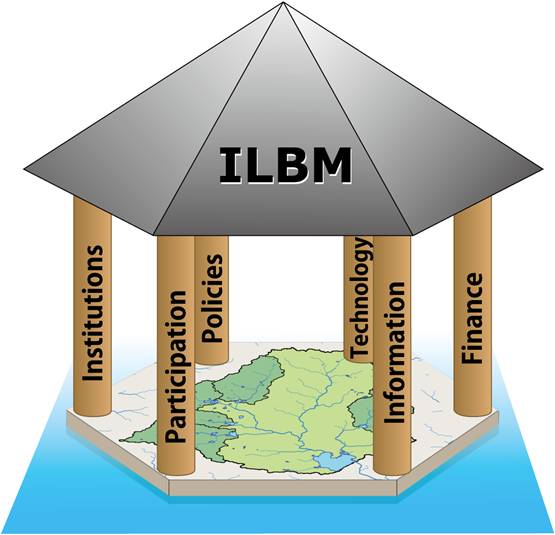
III. ILBM Cases on Biodiversity
Global implementation of ILBM is still in its early stages, yet it has been gaining attention and participation in each project focal point shown in Figure 1, bearing a number of successful cases (http://www.ilec.or.jp/en/wp-content/uploads/2013/03/LBMI_Main_Report_22February20061.pdf). Among other things, ILEC is now focusing on further promoting ILBM for conservation of biodiversity and Socio-Ecological Production Landscapes (SEPL), particularly with regard to inland water basins where complex combinations of lentic and lotic water systems exist.

Figure 1: ILBM-related Case Study Lake Locations
The five case studies from the pink highlighted countries in Figure 1 are listed as related case studies in the end of this paper, each comprehensively illustrating how closely a sustainable management of inland water basins is related to their sound ecosystem and healthy human livelihood in coexistence with biodiversity. The project tasks and deliverables seen in these South / Southeast Asian and South American inland water basins are as follows.
In Nepal, the degradation of biodiversity in the Himalayan Lakes is an immediate concern, affecting not only human livelihood and agriculture, but also the entire ecosystem of fauna and flora in its catchment area. Under such circumstances, a promotion of ILBM initiated in Rupa, one of many Himalayan Lakes, has strengthened governance in the local municipalities which in turn restored their abundant ecosystem and boosted economy.
Mexico, where deterioration of the forest ecosystem in the Lake Chapala basin once caused a decline in agricultural production and an increase of the poverty level, is now presenting successful project outcomes from the ILBM approach. The formation of better organization and regulations helped mitigate deforestation, improve agricultural productivity, develop herbal medicinal technology and expedite cost effective eco-technologies, now all generating profits to local livelihood.
In the Philippines, a remarkable restoration of SEPL has been achieved through an implementation of sustainable management in Tadlac Lake. Triggered by the lake turnover and fish mortality from intensified aquaculture proliferation in the late 90s, stakeholders from the local authorities to residents all played important roles in the conservation movement which eventually lead to fundamental consideration for a successful ecotourism program.
India presents two cases from different approaches. The one in the Western Indian tribal belt promotes ILBM as a solution to child malnutrition, which is a challenge imposed by the loss of biodiversity in the regional forest area under the persistent threat of climate change. Now the pilot project conducted shows that all the existing water bodies can be exploited to obtain sustainable food security for the local tribes to eradicate child malnutrition without any external support.
On the other hand, the case in Ujjani Reservoir, where severe river pollution is putting the lives of marginalized people at risk, proves that ILBM is also applicable to river (lotic) basin management. One of the remarkable approaches in their ILBM promotion is utilization of an inventive eco-technology called green bridge, a grafting ecosystem filter to improve self-purification capacity of stream availing bacteria in the local ecosystem.
Despite the background difference, we can observe several measures and effects common in all cases. First of all, strengthening the governance as symbolized in the six pillars of ILBM is a primary step in implementing sustainable basin management. This means their basin management plans and programs for resource development, use and conservation would not be sustainable without a support of appropriate governance framework gearing together as characterized in Figure 2.

Figure 2: Planning and Governance Must be Properly Geared Together for Sustainable Basin Management
In addition, participation of stakeholders plays an essential part in realization of sustainable lake or river basin management. A lack of awareness of the impacts (of their actions on the aggravated water resources can deter the conservation process. Therefore it is important to continuously work on the wider dissemination of information through educational programs, systems and institutions that can not only help stakeholders learn the proper use of their water resources and understand regulatory interventions, but also encourage them to participate in related grass-root activities.
Eventually, extensive participation under strong governance evolved over time would duly lead to biodiversity enhancement and socio-ecological production landscapes back into the region, which could also bring about better livelihoods. It would also lead to enhancement in local economy, not only through sanitation improvement, but also creating more jobs in such areas as ecotourism, environmental education, and eco-technology applications.
IV. Development of the ILBM Platform Process
The ILBM concept, having evolved from the past lake basin management experiences globally, is continuing to evolve. With such developments in recent years, ILEC has launched a new guideline book entitled “Development of the ILBM Platform Process: Evolving Guidelines through Participatory Improvement” (now available on ILEC official website: http://www.ilec.or.jp/en/). The guideline book presents the ILBM Platform, or a virtual stage for improving basin governance through ILBM.
General Steps of the ILBM Platform Process
The ILBM Platform Process takes the following steps for all platform members: The first step is to acknowledge the state of their lake basin management by making a lake brief, or a collective action report. Table 2 is a general outline of the report which helps systematically raise appropriate questions for corrective actions. The second step is to identify and analyze the issues, needs and challenges regarding the six pillars of ILBM, and the third step is to integrate the ways and means to meet the governance challenges and implement actions.

Once the Platform is formed, the existing lake basin management information can be compiled and analyzed as necessary and as possible, by a small expert group formed to undertake the platform supporting activities. If feasible, the collected and analyzed data and information can be transformed into inventories of data and information and made available through a database and a knowledge base. The team may then be able to share the results with a much broader circle of stakeholder organizations, as a means of deciding on their respective roles and responsibilities for pursuing concerted actions.
ILBM Platform May Grow to Become a Cyclic Process
How each of the case study lake basins will be able to improve its governance toward sustainability depends on a number of factors. For some, the conventional approach in planning, without explicit reference to the concept of ILBM, may be adequate for addressing their sustainable management. But the experience and lessons learned from the ILBM cases compiled over the years imply two things quite clearly. Firstly, since lake basin management is not a project but a long-term governance improvement process, it has to evolve over many years and decades toward sustainable resource development, use and conservation. Secondly, even without calling it ILBM, the process adopted in successful lake basin management cases entail gradual but continuous improvement of lake basin governance. This idea is presented as a Cyclic ILBM Platform Process in Figure 3.
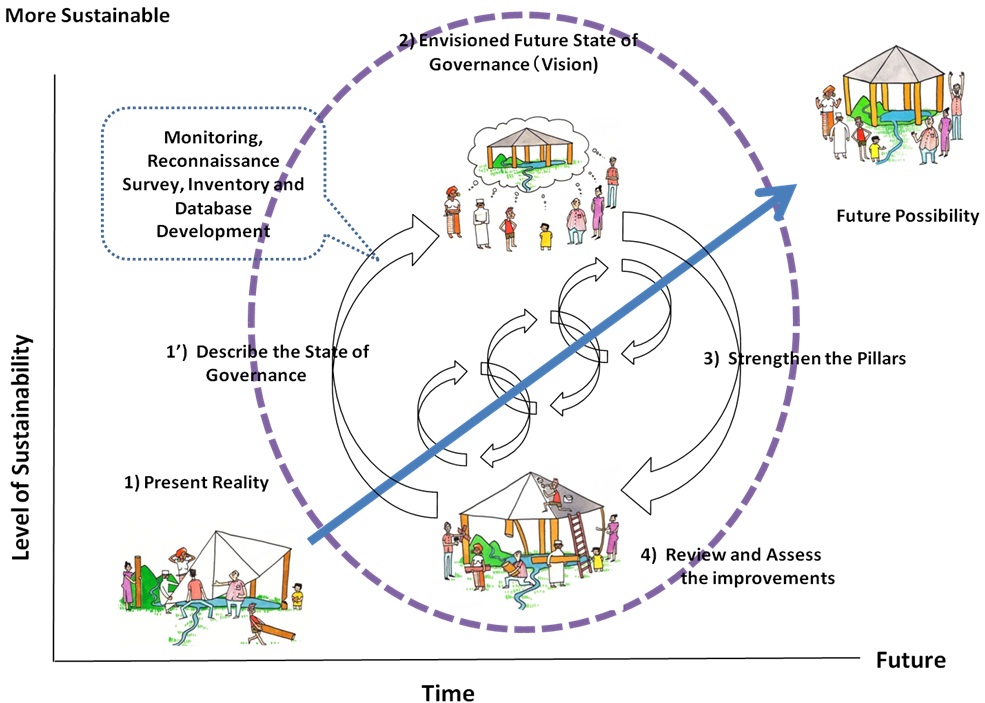
Figure 3: Schematic Illustration of a Cyclic ILBM Platform Process
The gradual envisioning step in the cyclic process of governance improvement has important implications for many of the emerging issues facing us, not only within the context of lake basin management, but also within the broader issues of sustainable livelihoods in the face of a growing need to deal with such complex issues as climate change impacts, diminishing biodiversity, health threats associated with both acute and chronic problems stemming from degraded lentic water environments, as well as the catastrophes associated with hydrologic extreme events such as floods and droughts, which often defy our capability to predict. Surprisingly, in fact, the number of ILBM applications is increasing in these areas, which go beyond the realm of the conventional concept of lake basin management.
Challenges and Prospects of the ILBM Platform Process
The challenges facing ILBM are obviously enormous. The process presented in the ILBM Platform is still in its infancy, as far as its recognition to deal with the mainstream water issues debated in the international community is concerned. Nevertheless, as the majority of the accessible freshwater resources on our planet are interlinked lentic-lotic systems of various levels of complexity, and their requirement for special care in management that has not been well understood, with most of the international fora having overlooked this aspect, it is time that ILBM emerges and plays an important complementary role in managing not only lakes and reservoirs, but the range of other water systems within their basins and beyond. ILEC will continue collaborative work with its worldwide counterparts for further development and proliferation of the methodology, whose process has the following merits described in Table 3.

V. Knowledge Base and Database for Sharing and Learning from the Global Experience
“LAKES”: Knowledge Base cum Knowledge Mining System
An enormous quantity of information has been generated so far, and will continue to be generated, on a wide range of subjects pertaining to lake basin management, both on a national and international basis. Much of it pertains to natural science topics, including physical, chemical and biological aspects (limnology, hydrology, climatology, ecology, biochemistry, etc.), all of which contribute to understanding the state of lakes, reservoirs and other lentic water bodies, both individually and collectively. There also is a growing number of studies on the managerial aspects of aquatic, terrestrial and riparian ecotone systems, including water quality, sediment, and riparian environment improvements as well as those of inflowing and out-flowing water systems extending out to the upper watershed tributaries.
Given this situation, developing and sharing the knowledge being continually generated and accumulated is ever more important, particularly with regard to the ILBM Platform approach or any other approaches adopted in different parts of the world. For the purpose of addressing this goal, an interactive knowledge base with knowledge mining system, called LAKES (the Learning Acceleration and Knowledge Enhancement System) has been developed at the Research Center for Sustainability and Environment, Shiga University, Japan (RCSE-SU), in collaboration with the National Research Institute for Humanity and Nature (RIHN), Kyoto, Japan). A screenshot of “LAKES” is shown in Figure 4. LAKES currently has the capacity to process several hundred documents for ‘mining’ the imbedded knowledge with the use of free keywords, as well as the use of a prepared thesaurus, ranging from the level of the whole documents, pages, paragraphs, or even individual sentences. LAKES also is linked to the World Lake Database described below, and will soon be linked to Geographic Information Systems (GIS) resources and other important websites providing for complementary sources of data and information.
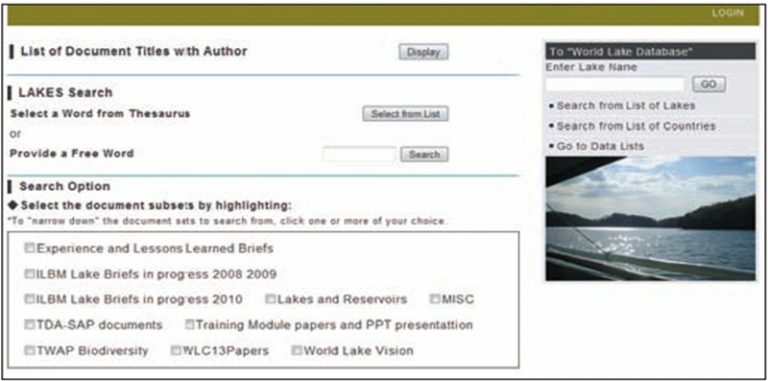
Figure 4: A Screenshot of “LAKES”
“World Lake Database”
As a repository of the output of Survey of the State of World Lakes (1986- 1988), a database system called the World Lake Database was developed and made accessible through the ILEC official website for those interested in reviewing and downloading information and data for individual lakes, as well as for cross-cutting analysis among the lakes of water quality parameters. This system can also serve as a depository of lake basin management data that may already have been generated and made public only in the form of hard-copy reports and technical papers, but not in an electronic database because of an inability to develop and maintain such a system. As the number of ILBM-related efforts increases, such a need will increase as data and information compiled in the form of Lake Briefs is also expected to grow. A screenshot of the World Lake Database is shown in Figure 5.

Figure 5: A Screenshot of “World Lake Database”
Therefore, “LAKES” and “World Lake Database” are both intended to be meaningfully linked for prospective ILBM activities in order to make the best use of the already-existing information facilities and data sources that have been available for public access. The web links to these two knowledge base and database systems are listed in the end of this paper, together with other related global database systems on inland water management.
VI. Expanding the Scope of ILBM Application to Other SEPL Cases
With the aforementioned merits of the ILBM Platform Process and together with the associated knowledge base and database mining systems, ILEC will continue collaborative work with its worldwide counterparts for further development and promotion of sustainable inland water basins and biodiversity management. Figure 6 illustrates how ILEC’s major proposal with the platform process and knowledge mining systems could work in an enhanced global network, including its future partners under IPSI.
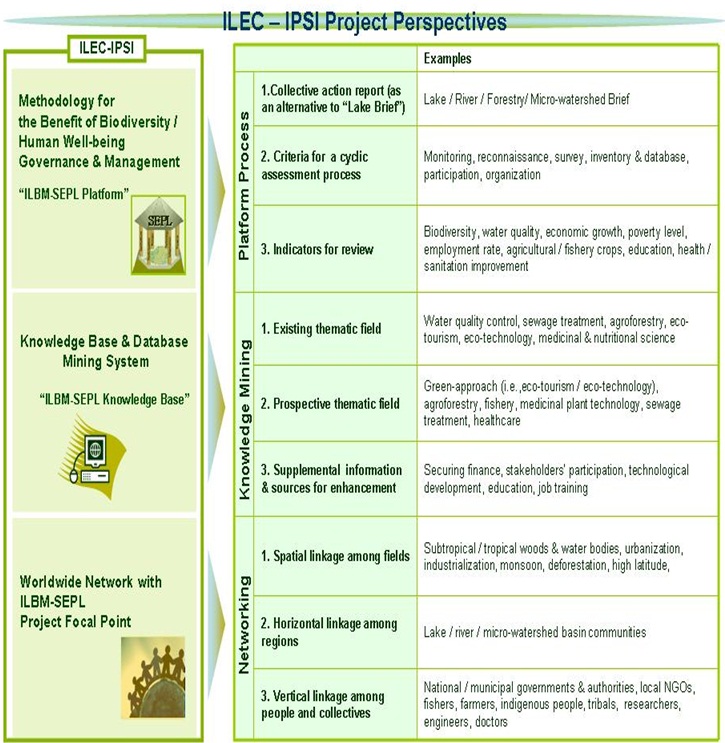
Figure 6: Proposal Diagram, “ILEC – IPSI Project Perspectives”
As examples of the figure above, Table 4 shows how the other five case studies in Nepal, Mexico, the Philippines and India could further extend their ILBM project by using the assessment methodology of ILBM Platform Process, and also analyze the linkage with other related project focal points by using knowledge mining systems like LAKES and WLDB.
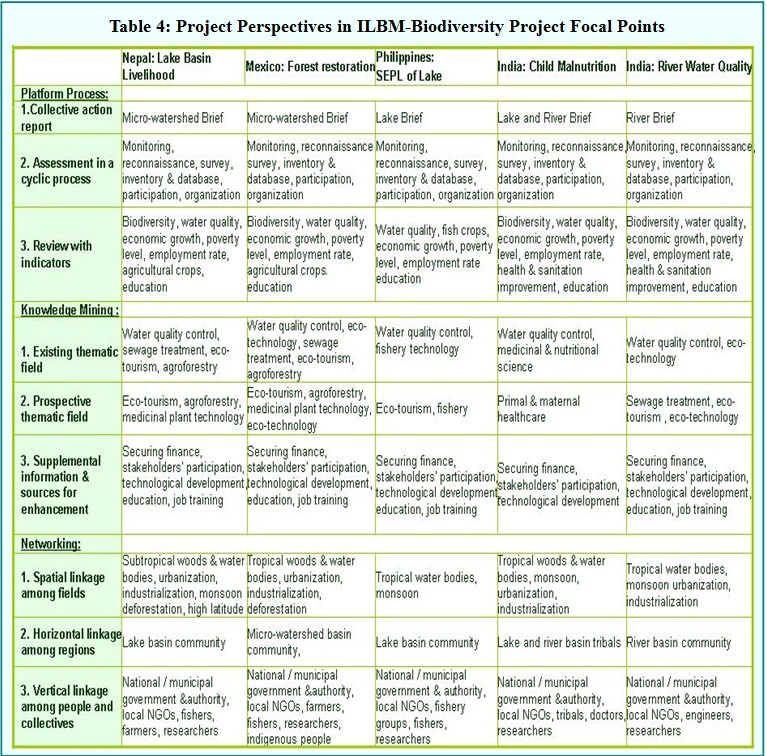
VII. Conclusion
Although ILBM was initially developed for the field of lake basin management, its methodology can be applied to a wide range of environmental issues with governance improvement challenges. Thus, the six pillars of governance for ILBM may well be the six pillars of governance for SEPL. The ILBM Platform Process can be adapted as a SEPL methodology, as a SEPL Platform Process. As shown in Figure 7, the conceptual framework and strategic program may serve as an efficient approach for managing various universal ecosystems and environmental resources for sustainable co-existence and mutual use, through a gradual, continuous and holistic, global improvement of their governance over a long period of time.

Figure 7: Proposal Diagram, “ILEC’s Contribution to IPSI”
List of Attachment
Attachment 1: Brochure of ILEC
ILEC has been working on the following major activities in collaboration with its world-wide counterparts from the academic, administrative and private sectors since 1986:
Organizational support for the World Lake Conference
- Planning with local host organization, Dissemination of information
Implementation of international collaboration projects on lake basin management, including promotion of Integrated Lake Basin Management (ILBM)
- Organization of joint workshops, development of ILBM self-learning tool / knowledge-based data base
International Cooperation
- Support and participation in international projects (GEF, World Bank Projects)
- World Lakes Student Conference
- Training / Education
- ILBM Training, Hands–on Environmental Education, Environmental Education on Water Environment (commissioned by JICA).
Attachment 2: Related Case Studies
– S.Pokharel, M.P.Neupane, M.Khadka. “Governance at Community Level for Conserving Himalayan Lake Rupa in Kaski District of Nepal”
– A.J.Aguilar, R.V.Moreno. “Community Forest Restoration for the Integrated Management of Lake Chapala Basin”
– A.C. Santos-Borja, C.Malana-Muan, E.B. Almero- Peña, M.Erasga. “Multi-Stakeholders’ Efforts for the Sustainable Management of Tadlac Lake, the Philippines”
– N.S.Tekale, M.S.Kodarkar, P.Karnik, R.Singh. “Integrated Lake Basin Management (ILBM), Impacts on Biodiversity and Child Malnutrition: A Case Study of Tribal Belt in Western Part of India”
– S.Joshi. “Ujjani Reservoir: People’s Initiative for Protection of Water Quality”
Attachment 3: Supplementary Document
– User’s Manual: LAKES V2
Website Links
Related Organizations
– International Lake Environment Committee Foundation (ILEC): http://www.ilec.or.jp/en/
– Research Center for Sustainability and Environment, Shiga University, Japan (RCSE-SU): http://rcse.edu.shiga-u.ac.jp/eng/index.htm
Related Past Projects
– Outline of Lake Basin Governance Research Promotion Activities, 2008-2010 (project associated with Ministry of Education, Culture, Sports, Science and Technology, Japan): http://rcse.edu.shiga-u.ac.jp/gov-pro/eng/
Global Database and Information Sources on ILBM
- LAKES V2: http://www.lakes-sys.com/staffs/login
- World Lake Database: http://wldb.ilec.or.jp/
- Global Environmental Monitoring Systems (GEMS): http://gemstat.org/
- International Data Center for Hydrology of Lakes and Reservoirs: http://www.hydrolare.net/
- International Waters Learning Exchange and Resource Network: http://iwlearn.net/
- Capacity Building for Sustainable Water Resources Management: http://www.cap-net.org/
- Global International Water Assessment (GIWA): http://www.unep.org/dewa/giwa/
References
The following publications on ILBM are available for PDF download on ILEC official website (http://www.ilec.or.jp/en/):
(1) Development of ILBM Platform Process: Evolving Guidelines through Participatory Improvement, 1st printing: http://www.ilec.or.jp/en/wp-content/uploads/2013/02/Development-of-ILBM-Platform-Process_2nd_Edition11.pdf
(2) Managing Lakes and their Basins for Sustainable Use: http://www.ilec.or.jp/en/wp-content/uploads/2013/03/LBMI_Main_Report_22February20061.pdf
(3) How Can We Stop Degradation of the World’s Lake Environments? (A User’s Guide to “Managing Lakes and their Basins for Sustainable Use”): http://www.ilec.or.jp/en/wp-content/uploads/2013/03/ILBM_Report_E_07oct02.pdf
(4) Integrated Lake Basin Management (A Summary of “Managing Lakes and their Basins for Sustainable Use”: http://www.ilec.or.jp/en/wp-content/uploads/2013/02/ILBM-leaflet_er.pdf
(5) Guidelines for Lake Brief Preparation: http://www.ilec.or.jp/en/wp-content/uploads/2013/02/Guidelines_for_Lake_Brief_Preparation_2.pdf



